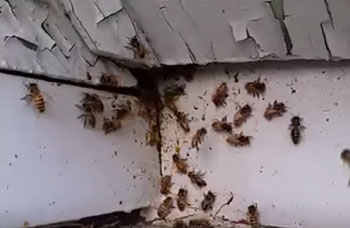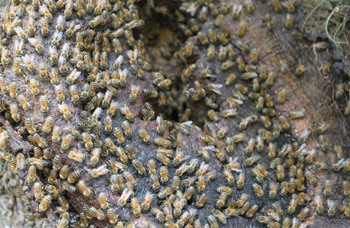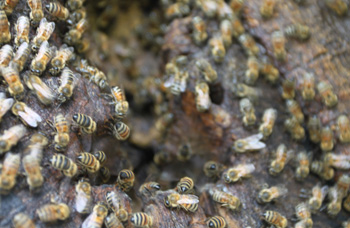Bees
Carpenter Bee Facts
- Typically 18 to 20mm in length.
- Adult resembles a bumble bee, except abdomen is almost hairless and is a metallic blue-black colour.
Bee Photos
-
 Honey Bees
Honey Bees -
 Honey Bees
Honey Bees - View More Photos
Carpenter Bees
Nesting habits in wood and structural timbers give the carpenter bee its name. Often confused with bumblebees because of their size and coloring, carpenter bees are known to make appearances outside of homes and in gardens during the late spring and early summer months. Indeed, given the 500 or so species spread across the globe, many popular references to bumblebees actually refer to this less-hairy cousin.
Both genders of carpenter bee are relatively harmless unless provoked, with males being more aggressive but lacking stingers. Unfortunately, due to their burrowing habits in wood, the bees can cause damage to structures if allowed to continue unchecked. In some species, sisters and daughters may overtake a single structure leading to more extensive tunneling and subsequent damage.
What Are Carpenter Bees?
Carpenter bees are large insects bearing a striking resemblance to bumblebees. Roughly 1/2-inch to 1-inch long, the bees can be distinguished by shiny, as opposed to hairy, abdomens. In general, coloring is blue-black and yellow or black and orange.
Carpenter bees spend much of their lives traveling from their nest to obtain food from nearby flowers. As such, the bees can be hard to spot and are more likely to be identified by their distinctive humming sound and nesting holes.
Carpenter Bee Infestation
While initial damage from carpenter bees is limited to a small nesting hole, that hole is likely to be expanded by subsequent generations. Over time, structural damage may occur as the bees branch out into new and larger tunnels. Since these expansive structures are hidden, identifying a problem can be difficult. Keep an eye out for bare, weathered or unpainted wood areas and holes or indents that appear to be perfectly round. Additional identifiers include fresh sawdust and a humming sound from within the wood structure.
How to Get Rid of Carpenter Bees
Nests with liquid or dust insecticide formulations are the most effective ways to eliminate bees, eggs and larvae. Currently permethrin and cyfluthrin in liquid formulations and dusts with boric acid are approved and effective in use against carpenter bee infestations. For a lower-toxicity and longer-lasting option, desiccant dusts may be combined with diatomaceous earth or boric acid powders and applied to the problem area.
If carpenter bee infestations are a recurrent problem, insecticide treatments should be carried out in the spring, mid-summer and early fall months. In general, prevention is the best treatment method and can be achieved by filling potential nesting holes with wood putty or steel wool.


